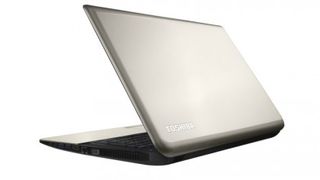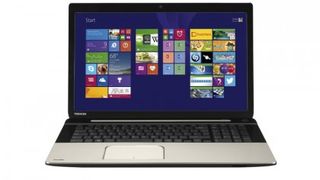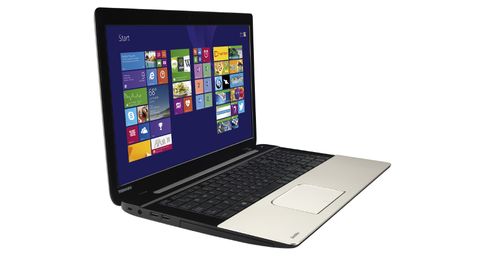Why you can trust TechRadar
- PCMark 8 Home: 2,293
- PCMark 8 Home battery life power saver 25% screen: 5 hrs 36 mins
- PC Mark 8 Home High Performance 50% screen battery life: 3 hrs 38 mins
- 3DMark: Ice Storm: 31,828; Cloud Gate: 3,896; Fire Strike: 529
- Cinebench R11.5: CPU: 2.48; Graphics: 16.23
- Cinebench R15: CPU: 230cb; Graphics: 21.77
In PCMark 8's Home test the Toshiba scored 2,293 points. That's a sliver ahead of the Lenovo Flex 2 15, which had a similarly-powered Core i5 part, but it couldn't catch its stable mate – the Toshiba Satellite S50D-A-10G, with its AMD APU, scored 2,611 points.
The Toshiba proved more successful in the Cinebench tests. In version R15 of the benchmark the L70 scored 230 points – the same score as the Lenovo, and ahead of the 118 scored by the Toshiba.
The L70 might trade blows with the competition, but it's unable to pull ahead of any of its rivals. It's a machine that's comfortable with low-end tasks and general computing, but it won't handle anything more demanding.

Gaming gulf
The Toshiba didn't impress in gaming tests. Its result of 31,828 in the low-intensity 3D Mark Ice Storm benchmark lags behind both rivals, and the gulf is clear in the tougher Fire Strike test. In this high-end benchmark, the L70's 529-point result is only ten points behind the Lenovo, but it's less than half the pace on offer from the other Toshiba. If you want a laptop that's affordable but can still play games, the L70 isn't it – buy the S50D instead.
Our standard battery test uses PCMark 8's Home benchmark with Balanced power mode and the screen at 50% brightness. The Lenovo lasted for 3 hours 38 minutes, which isn't far behind the S50D – and more than thirty minutes more than the Lenovo managed. We increased the L70's result to beyond five hours by using Power Saver mode and toning down the screen brightness.

Display shortcomings
The screen has a 1,600 x 900 native resolution. That's an improvement on the 1,366 x 768 screens found on most budget 15.6-inch laptops – including both rivals – but it still feels disappointing. With a 17.3-inch diagonal, we would have preferred a 1,920 x 1,080 resolution, which would have improved the L70's versatility and made Windows 8.1 and its icons look smaller and sharper. As it is, the entire OS looks overblown and rough around the edges.
Our benchmark results also indicate that this screen isn't cut out for serious work. Its colours aren't accurate enough, as a poor average Delta E of 9.4 demonstrates, and its colours are affected by colder tones – the colour temperature of 7,263K is a long way beyond the 6,500K ideal result.
The cold inaccurate colours are paired with poor contrast. The measured contrast ratio of 411:1 is better than the other Toshiba machine, but it's still an unimpressive score that means this panel lacks punch and vibrancy. The poor colour handling is further highlighted by the 73.2% sRGB gamut coverage level: again, it's better than the smaller Toshiba, but it's still nowhere near the best notebooks. On the L70, it means that reds, purples, pinks and darker blues are rendered particularly poorly.

Positives are tricky to find. The 267cd/m2 brightness level is good, and means that this machine can be used outdoors and under bright office lights, and its glossy layer isn't obnoxiously reflective. Viewing angles are similarly accommodating.
Toshiba has switched from Beats to Skullcandy for its audio gear, but old issues remain. The L70 is one of the loudest laptops we've tested, but the audio produced is hampered by muddy, thick bass tones. They dominate the mid-range and high-end, both of which sound underwhelming. The lack of quality audio means we'd avoid using the L70's speakers for music or games, despite the booming volume.
Mike has worked as a technology journalist for more than a decade and has written for most of the UK’s big technology titles alongside numerous global outlets. He loves PCs, laptops and any new hardware, and covers everything from the latest business trends to high-end gaming gear.

